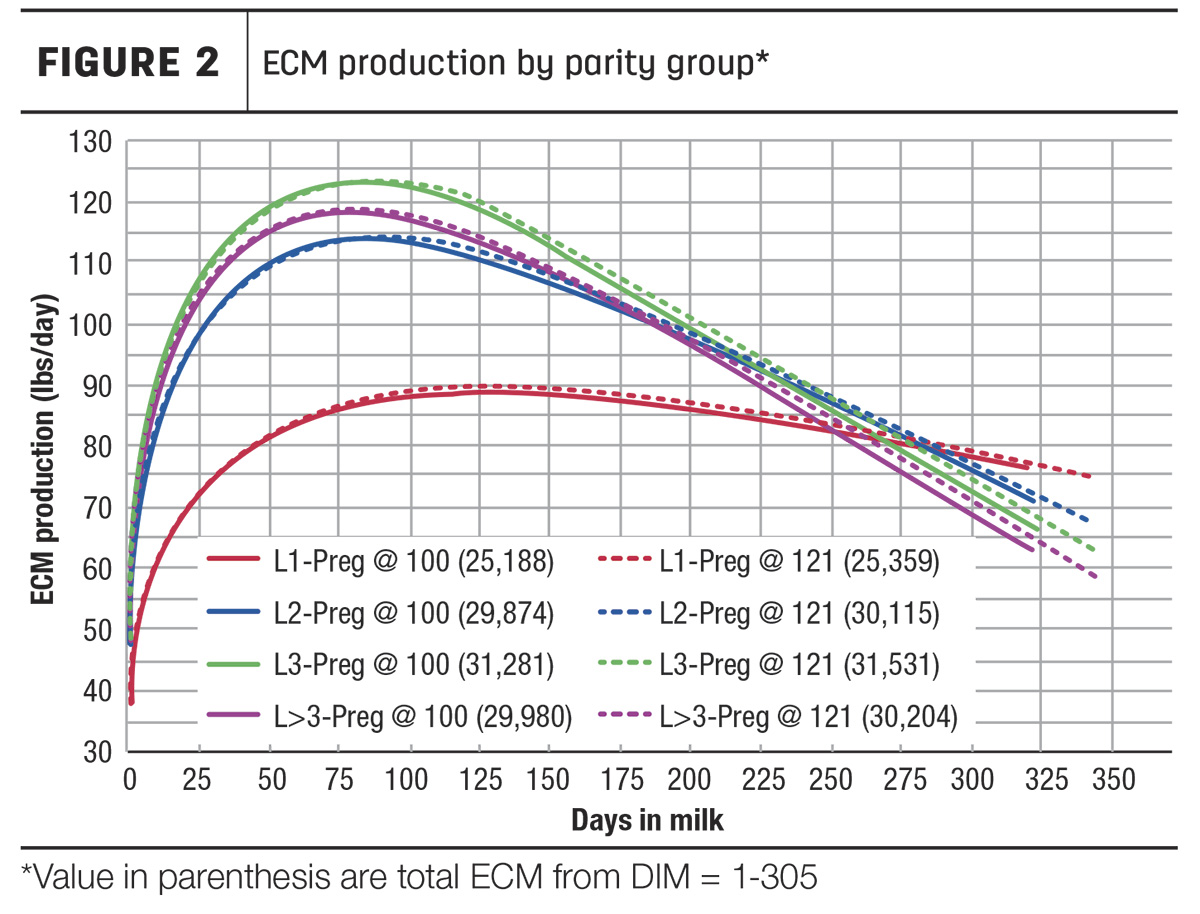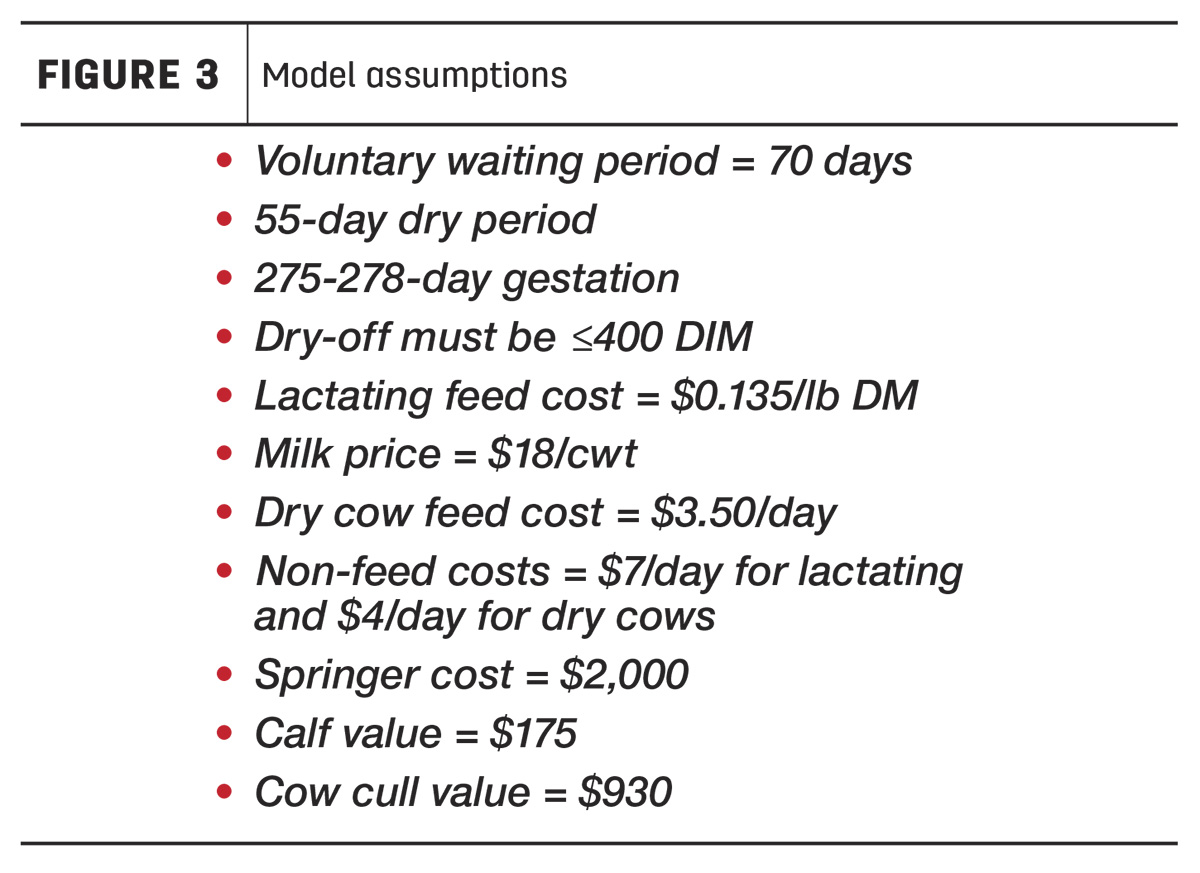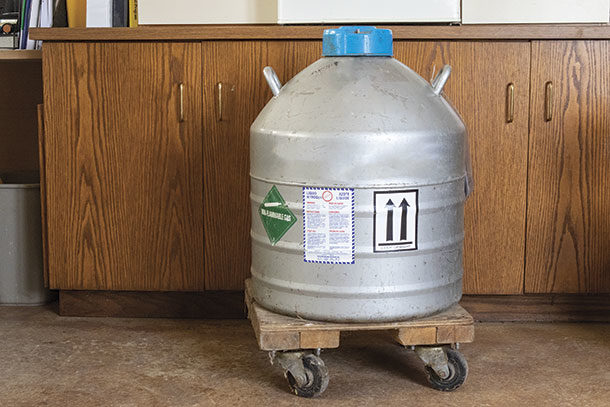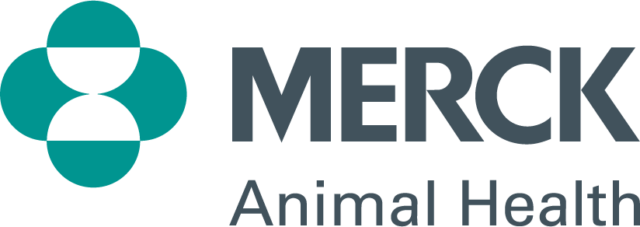Dairy reproductive efficiency has improved considerably over the last 10 to 20 years due to factors such as improved cow comfort, better nutrition, synchronization programs, sensors/monitors and genetic selection (Figure 1). Simultaneously, milk production has also increased for many of the same reasons, leading some producers to question if they are getting cows pregnant quicker than what is optimal.
With higher milk production and improved reproductive programs, it’s fair to wonder if a farm is leaving milk on the table by having lactations that are “too short.” After all, more lactating days equals more milk. When thinking about lactation length and milk production, one aspect to consider is maximizing the returns to your most fixed resource on the farm. Is your most fixed resource the cow or the stall she occupies? These questions, increasing industry efficiency, and personal discussions with several producers and consultants caused me to revisit the question: “What days in milk is the optimal time to get a cow pregnant?”

Lactation curves
The day a cow becomes pregnant determines two important things. First, the day in milk (DIM) at conception dictates the length of the lactation. All else equal, if a cow conceives 21 days later, her lactation will last an extra 21 days. Second, it will likely impact the persistency of the lactation curve. Cows that conceive earlier have lactation curves that are slightly less persistent (i.e., a steeper drop in milk yield after lactation peak). The general shapes of lactation curves are similar across operations. However, there are herd-specific differences with respect to peak milk yield, DIM at peak and persistency, suggesting that a customized analysis with data from your own herd is preferable to working with industry averages when trying to identify the optimal time to get cows pregnant.
I recently completed such a customized analysis for a herd wanting to know the optimal time for getting cows pregnant on their operation. The first step of the analysis is to estimate energy-corrected milk (ECM) lactation curves by parity group (I considered four lactation groups – L1, L2, L3, L greater than 3) using herd-specific production for the dairy and various factors impacting that production (e.g., seasonality, early disease incidence, age at fresh in first lactation, days in close-up pen, etc.), including when a cow became pregnant and days carried calf.
Figure 2 shows the estimated lactation curves for the four lactation groups for a “typical cow” (i.e., all model variables held constant at their means) that conceives at either 100 DIM (solid lines) or 121 DIM (dashed lines).

If a cow in this herd conceives 21 days earlier (100 versus 121 DIM), she produces an estimated 171 pounds less milk if she is in her first lactation (L1) and 238 pounds less milk on average if she is multiparous (average of L2, L3 and L greater than 3), standardized to a 305-day lactation. This demonstrates the effect early conception has on persistency. When lactation length is included, the total milk difference is 1,787 pounds less in first-lactation animals and an average of 1,635 pounds less for multiparous animals conceiving 21 days earlier (dashed lines). Thus, if the goal is to produce the most milk for a cow over an individual lactation or over her lifetime, getting her pregnant later will always produce more milk simply because this results in a longer lactation and more milk-producing days over her lifetime.
Milk vs. money and the importance of factoring in fixed costs
While production levels and economic returns often go hand in hand (i.e., the most profitable dairies tend to have better production), that is not always the case. To answer our question of “What days in milk is the optimal time to get a cow pregnant?”, I contend that an economic metric should be used rather than a production measure such as total milk in the lactation or lifetime milk. The analysis that follows considers two economic measures: income over feed costs (IOFC) and net cash flow (NCF), defined as:
Income over feed cost (IOFC) = Milk sales – Feed cost (includes lactating and dry cow feed)
Net cash flow (NCF) = Milk sales + Calf sales + Cull cow sale – Feed cost – Nonfeed cost – Springer cost
As defined here, net cash flow is basically total income minus total costs where the cost of the springer is an upfront cost rather than being amortized over the life of the cow. Feed cost has both a fixed and a variable component where the fixed part is feed for maintenance/growth and dry cow feed, and the variable part is tied to milk production (0.444 pound DM per pound of ECM). Nonfeed costs are fixed for the purpose of this analysis in that they are held constant regardless of production level.
While the above economic measures are straightforward, there are a couple of other issues to consider before determining the optimal DIM of conception. Calculations should also consider when income and expenses occur (i.e., the time value of money) and the endpoint for the analysis. Time value of money reflects the fact that a dollar today is worth more than a dollar at some point in the future when the interest rate is greater than 0%.
Income and expenses are adjusted by “discounting” them such that they are dimensioned in current dollars regardless of when they occur. For example, NCF defined above includes the cost of the springer, which is incurred at the beginning of a cow’s productive life, and cull cow income that is received at the end of her productive life. NCF ignores the timing of these cash flows, but discounting NCF (known as net present value or NPV) accounts for the fact that a dollar received as income at the end of a cow’s productive life is worth less than the cost of a dollar paid at the beginning of her productive life. Thus, in addition to calculating returns with IOFC and NCF as defined above, discounted IOFC and NPV returns are also calculated. Finally, when we consider whether we are trying to maximize the returns for an individual cow or if we are maximizing the returns to the stall she occupies on the dairy, we are considering different endpoints.
While IOFC is a useful metric for making some management decisions, it is a poor metric for determining the optimal time to get a cow pregnant because it ignores relevant costs. Continuing to milk a cow with low milk production may cover her feed bill, but it ignores operating and ownership costs (nonfeed costs) on the dairy and the fact that the stall she’s occupying is our most fixed resource. NCF is a much better measure than IOFC because it includes all income, nonfeed costs and the cost of the springer.
A better measure yet is NPV because it accounts for the fact that springer cost is incurred day 1 but cull cow income is not received until some point in the future. Rather than maximizing the return to the individual cow, we should maximize the return to the stall. When we think about maximizing the return to the stall, we effectively are saying we can “repeat the process” over and over. That is, at the end of a cow’s productive life, she will be replaced with another cow, and then after her productive life she will be replaced, and so on. Thus, the ideal metric is what is referred to here as NPV repeated, which is the discounted net cash flows for a cow over her lifetime and then repeating this process in perpetuity. Keep in mind: The further we go into the future, the less weight we put on the income and expenses due to discounting, but this approach allows us to better compare strategies where lactation lengths vary.
Back to the dairy
In the case of the herd wanting to determine the optimal time to get a cow pregnant, I constructed a model to calculate IOFC and NCF for every day starting with a springer at calving through five full lactations using assumptions listed in Figure 3.

These daily values were also discounted using an interest rate of 8%. Milk production was based on the herd-specific lactation curves estimated where the length and persistency of each lactation depends upon the DIM of conception. This model was used to find the optimal DIM a cow should get pregnant in each of her five lactations to maximize IOFC, discounted IOFC, NCF, NPV (discounted net cash flow) and NPV repeated (i.e., repeating discounted net cash flow in perpetuity).
Table 1 shows the optimal conception DIM by lactation and the resulting values for each of the five economic measures.

The total pounds of ECM and total days for the five lactations are also
reported. If the goal is to maximize IOFC (or discounted IOFC), a cow
should always be bred such that she gets pregnant as late in her
lactation as acceptable – in this case, the conception DIM that was
optimal resulted in the cow drying off at 400 DIM for each lactation
(i.e., the maximum allowed in the model). This results in greater
lifetime milk production compared to the NCF scenario due to longer
lactations (2,225 total days versus 1,871). If the goal is to maximize
NCF, then the optimal time to get first-lactation cows pregnant is also
as late as acceptable (180 DIM), but second-lactation cows move up to an
optimum of 119 DIM to get pregnant and cows in lactations three to five
at 70 to 96 DIM. This demonstrates that when nonfeed costs are
included, cows should optimally get pregnant quicker, as would be
expected (i.e., if we only include feed costs in our calculations a cow
will optimally be milked for more days). Why are first-lactation still
not near as quick as mature cows? This is due to first-lactation animals
having a much more persistent lactation curve (look back to Figure 2).
When income and expenses are discounted to account for the time value of
money (NPV), cows should optimally get pregnant quicker yet –
first-lactation cows now at 129 DIM, second-lactation cows at 100 DIM
and cows in lactations three to five at 70 to 83 DIM. Finally, when
discounting returns and accounting for the fact that the process can be
repeated into the future (NPV repeated – maximizing returns to a stall
as opposed to an individual cow), the optimal time to get a cow pregnant
is earlier yet, with first-lactation cows at 115 DIM, second-lactation
cows at 95 DIM and older cows all less than 80 DIM.
Do I really want more calvings in the herd if each calving is a risk and a stress on the cow?
A very simplifying assumption made for this analysis was that cows survive through five lactations (i.e., cows never die and are not sold until the end of their fifth lactation). Clearly this is not realistic, as we know there is risk of cows being removed for numerous reasons. When the risk of early removals (first 60 DIM) was included in this farm’s analysis, the optimal time to get cows pregnant increased slightly (on average +2 days for NPV scenario and +8 days for NPV repeated scenario, with most of the increase being in first-lactation cows). Removals in the first 60 DIM averaged 2.2% for this herd. As early removal risk increases, the optimal time to get cows pregnant will also increase. However, if early removals are high, it is more important to address what is causing that rather than delay breeding.
The objective of this analysis was to identify the optimal DIM for a cow to get pregnant, as opposed to the optimal voluntary waiting period. But given the results of this analysis suggest that cows in their second lactation or greater should generally get pregnant at less than 100 DIM, it does imply that making changes to your breeding program that delays when cows get pregnant would make economic returns worse off, i.e., if extending the voluntary waiting period results in average DIM of conception increasing, returns would decrease.
The unique value of this economic model is that it uses a herd’s own distinctive data and lactation characteristics rather than relying on academic studies or averages across the industry. This same analysis has been done with several other Holstein herds with one very consistent result: The optimal time to get mature cows (lactation 3 and greater) pregnant is as early as possible, but the results for first-lactation cows, and to a lesser extent second-lactation cows, has varied across herds due to the relative shapes of their lactation curves (i.e., their persistency). Absolute values of IOFC and NPV, and their discounted values, depend heavily upon price and cost assumptions; however, the optimal time to get a cow pregnant is not very sensitive to price and cost assumptions (at least across a “normal range” of values). In other words, the price of milk and feed (two biggest drivers of economic returns) should not drive your breeding decisions.
These analyses have been based on herd-level decisions; what about individual cows? As we continue collecting and analyzing more individual cow-level data, we will be able to identify the optimal time to get each individual cow pregnant, but for most people today we still are making herd-level decisions. Bottom line: The results of the analyses I’ve done to date would generally suggest producers should not delay breeding cows, especially mature cows. By getting cows pregnant early, they might be leaving milk on the table, but not dollars.








